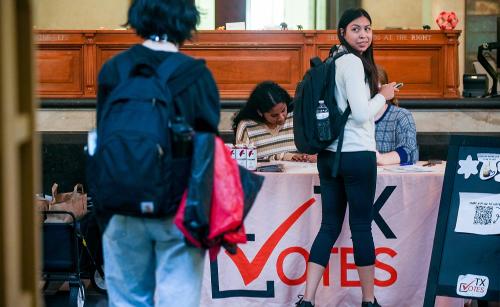One of the many strange things about the modern presidential nominating system is that the results of the California primary—the biggest state in the union—will probably not matter much at all, no matter who wins. On the Republican side of course, the race is over. But even on the Democratic side an upset by Senator Sanders will do little to change the outcome of the race.
Why should the outcome of a primary in the biggest state in the union mean so little? Most people think it’s because California comes last. But that is not the whole story. In past elections, California occupied an enviable late-in-the-primary position, enviable because of its all-important ability to end—or upend—the nomination race.
This is no longer the case.
The reform movement between 1968 and 1972 changed the presidential nomination system from a semi-public system dominated by super-delegates to a public system dominated by primaries that bound delegates according to the outcome. Once the primaries became binding on delegates’ first-ballot voting, there had to be rules to determine how the delegates would get awarded to the presidential candidates.
All election systems need such rules. On one end of the spectrum are proportional rules—delegates get awarded based on the number of votes in a state or a sub-unit of a state such as a congressional district—or some equation-based combination of the two. On the other end of the spectrum are winner-take-all rules—all the delegates get awarded to the winner of the state. Between 1972 and 1992 the Democratic Party fought about these rules. In 1972 George McGovern won the big California primary. In that year California was still winner-take-all and McGovern’s huge delegate haul gave him solid control over the convention. The ABM Movement (Anybody-But-McGovern) challenged the winner-take-all rules at the convention in an attempt to deny McGovern the nomination. Yet, the McGovern forces, (acting against their personal beliefs about how the system should work), beat back the challenge and nominated McGovern.
By 1992, however, after some degree of internal party conflict, the Democratic Party had settled its 20 year debate on the topic. All states had to adopt proportional rules for awarding delegates to presidential candidates. The Republican Party has retained the ability for states to give all the delegates to the winning candidate but in recent years, they have increasingly adopted “hybrid” systems which allow for winner-take-all at the district level and some sort of proportional allocation at the state level (often unless a candidate wins a super-majority of the statewide vote).
What is most interesting about the trend towards proportionality is the extent to which the rules have changed the presidential nominating process from a state-by-state race to a race in each of the country’s 435 congressional districts. Winning a bunch of small states or winning a bunch of states by outsized margins has become the key to winning the nomination. This effect was foreseen decades ago by two political scientists, James Lengle and Byron Schaefer. Writing in 1976 they observed:
“A state’s ‘political value’—the delegate margin obtained by the candidate who finished first in its primary—would have corresponded exactly with the size of delegation authorized by national party rules. The key battlefields would have been generally northeastern, urban, industrial, minority-oriented, populous and two-party competitive in November, while the lesser ones would have been southern and western, more rural, agricultural, homogeneous, sparsely populated and politically one party.”
Ironically, proportional rules put the two political parties (but especially the Democrats) at odds with the rules of the Electoral College which dominates the general election. The Electoral College is (with two small exceptions in Maine and Nebraska) winner-take-all. In the Electoral College, big states matter. Any political party that can put California in its corner (as the Democrats seem to be able to do these days) has a big advantage in the general election—giving a candidate over 20 percent of the electoral votes needed to win the general.
Not so in the primaries. The contest in both parties but especially in the Democratic Party has become a district by district contest.
Senator Sanders and his supporters have spent a great deal of energy criticizing many aspects of the Democratic nominating system. But they have focused less on the proportional rules that govern pledged delegates than they have on super delegates. If California were still a winner-take-all state, as it was for many years, an upset win by Sanders would net him a whopping 475 pledged delegates and turn this into a real race to the convention. But as it is—even a clean win in a proportional representation system will result in a split of the delegates and will do little to change the outcome of this race.
Elaine C. Kamarck is a Senior Fellow at the Brookings Institution and author of Primary Politics: Everything You Need to Know about How America Nominates Its Presidential Candidates. She is a superdelegate to the Democratic convention.


Commentary
Why winning primaries in big states like California doesn’t matter anymore
June 5, 2016